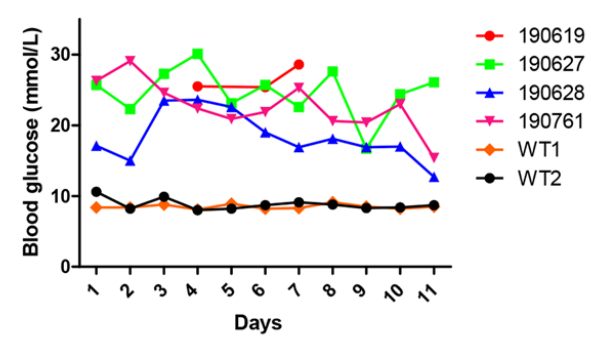点击展开
Gene editing dog model
Gene editing dog model
Background Information
1Neonatal diabetes
Neonatal diabetes is a rare and special type of diabetes that occurs within the first 6 months of life. According to different clinical manifestations, it can be divided into temporary neonatal diabetes and permanent neonatal diabetes. Permanent neonatal diabetes is the main type of neonatal diabetes. Compared with temporary neonatal diabetes, its clinical symptoms are more serious and its onset is often in ketoacidosis. In addition, there is no spontaneous remission after the onset of permanent neonatal diabetes, requiring lifelong treatment. The disease is mostly autosomal dominant inheritance.
Clinically, there is usually a lack of typical manifestations of "three more and one less", and only a few children go to the hospital because of "polydipsia and polyuria". Most of the children were aggravated by infection, and most of the children were already in a state of ketoacidosis when they saw a doctor.
1) Children may present with low birth weight or small for gestational age.
2) Different degrees of ketoacidosis may occur, and in severe cases, symptoms such as loss of appetite, nausea, vomiting, ketone odor (like rotten apple flavor) in exhaled air, lethargy and irritability may occur.
3) High incidence of dehydration, severe dehydration, cold limbs, weak pulse, rapid heart rate, low blood pressure and other shock symptoms; Polydipsia, eat well, but severe cases are not.
2Gck Gene
kinase, this enzyme is not inhibited by its product glucose 6-phosphate and remains active when glucose is abundant. In the pancreas, the enzyme plays a role in glucose-stimulated insulin secretion, while in the liver, the enzyme is important in glucose uptake and glycogen conversion. Mutations in the GCK gene have been associated with many types of diabetes and hyperinsulin-hypoglycemia. The canine Gck gene contains 8 exons in total. We used CRISPR/Cas technology to conduct gene targeting on the second exon of this gene, and finally obtained the C→T point mutation diabetic disease model dog.

Results of F0 generation of model dogs
1Blood glucose
The blood glucose level of mutant dogs was significantly higher than that of wild type dogs.

2Weight
The weight gain of mutant dogs was significantly slower than that of wild-type dogs.